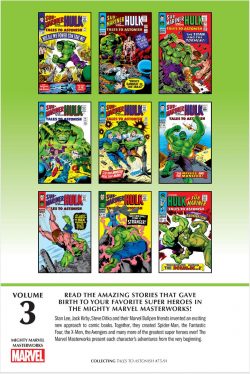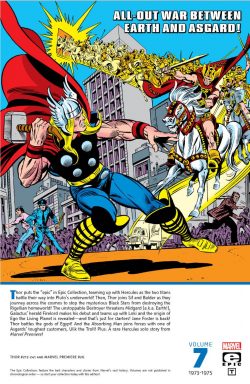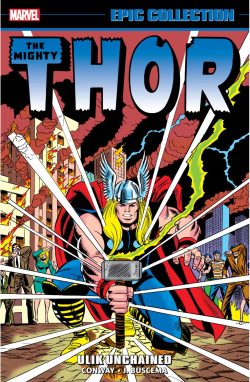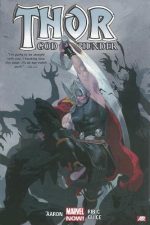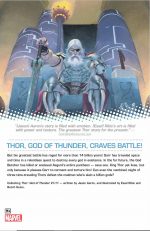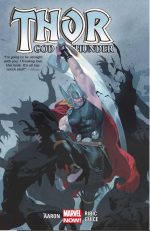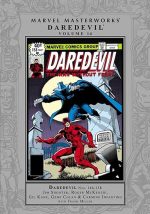
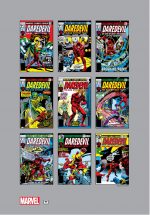
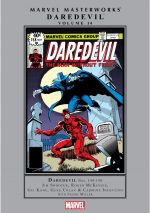
By Jim Shooter, Roger McKenzie, Gil Kane, Gerry Conway, Jo Duffy, Don McGregor, Gene Colan, Carmine Infantino, Frank Miller, Lee Elias, George Tuska, Frank Robbins, Tom Sutton & various (MARVEL)
ISBN: 978-1-3029-2163-7 (HB/Digital edition)
Matt Murdock is a blind lawyer whose remaining senses hyper-compensate, making him an astonishing acrobat, formidable fighter and living lie-detector. A second-string hero for much of his early career, Daredevil was nonetheless a striking and popular one, due mostly to the captivatingly humanistic art of Gene Colan. DD fought gangsters, super-villains and even the occasional monster or alien invasion, quipping and wisecracking his way through life and life-threatening combat, utterly unlike the grim, moody, quasi-religious metaphor he became.
After a disastrous on-again, off-again relationship with his secretary Karen Page, Murdock took up with Russian emigre Natasha Romanoff, infamous and notorious ex-spy The Black Widow. She was framed for murder and prosecuted by Matt’s best friend and law partner Franklin “Foggy” Nelson before the blind lawman cleared her. Leaving New York with her for the West Coast, Matt joined a prestigious San Francisco law firm but adventure, disaster and intrigue sought out the Sightless Sentinel and ultimately drew him back to the festering Big Apple. When they finally split up, Murdock and his alter ego remained to champion the law and justice their way…
Spanning April 1977 to March 1979, this pivotal collection gathers Daredevil #144-158, plus a sidebar spin-off from Marvel Premiere #43, subtly shifting the tone and feel of the long-running feature as the Man Without Fear hovers on the brink of a major overhaul and global super-stardom.
Following incoming scripter Roger McKenzie’s reflective Introduction ‘Dreams’, the heroic endeavours resume with writer Jim Shooter, penciller Lee Elias & inker Dan Green amping up the edginess and darkening the foreboding shadows by proving ‘Man-Bull Means Mayhem’ as the petty thug-turned-mutated-menace Bill Taurens again clashes with the Crimson Crusader. The battle begins when he breaks jail to join DD’s oldest archenemy The Owl and it emerges the avian ganglord is critically enfeebled, under attack by rivals and needs the Man-Bull to kidnap the one scientist who can fix him. Sadly, the boffin might also be able to cure Taurens, and the brute’s selfish betrayal leads to disaster when Daredevil intervenes again…
The Owl’s fate is sealed in ‘Danger Rides the Bitter Wind!’ (Shooter from Gerry Conway’s plot, illustrated by George Tuska & Jim Mooney) as the desperate raptor goes after Dr. Petrovic personally, raiding a hospital and triggering his own doom in a rooftop clash with Daredevil. Shooter then amped up the tension as #146 saw Gil Kane pencilling for Mooney as maniac marksman Bullseye returned to force a showdown ‘Duel!’ with the hero by taking a TV studio hostage before being defeated again…
Throughout The Jester’s media reality war, Daredevil had dated flighty socialite Heather Glenn. When, as both masked hero and lawyer he discovered her father was a corrupt slumlord and white collar criminal, he began looking for proof to exonerate his potential father-in-law, but everywhere came further damning proof. Matt Murdock’s girlfriend knows her dad isn’t a ruthless, murdering monster and that someone must have framed him. All evidence says otherwise…
Now another long running plot thread – which had seen Foggy’s girlfriend Debbie Harris kidnapped and held for months – converges as DD confronts Maxwell Glenn and the true culprit reveals himself to readers if not the hero. As Glenn confesses to everything and is arrested, the hero hits his ‘Breaking Point!’ (Shooter, Kane & Janson) after dramatically liberating the broken captive but failing to catch the true villain – mindwarping former foe Killgrave, the Purple Man…
With Kane co-plotting, and Glenn actually believing himself guilty, #148’s ‘Manhunt!’ sees the increasingly overwhelmed adventurer lash out at the entire underworld in search of the malign manipulator, only to stumble into a wholly separate evil plot instigated by the diabolical Death-Stalker. Murdock’s relationship with Foggy also takes a hit as the usually genial partner deals with a PTSD ravaged Debbie and can’t understand why his best friend is defending self-confessed perpetrator Glenn…
For DD #149 Carmine Infantino joined Shooter & Janson as ‘Catspaw!’ sees Heather dump Matt and super-thug The Smasher target Daredevil in a blistering battle bout that is mere prelude to #150’s ‘Catastrophe!’ which finds the hero stretched beyond his capacity in court and on the streets just as charming mercenary Paladin debuts in a clash of vigilante jurisdictions. The debuting mercenary hero for hire is also after the Purple Man and has advantages DD can’t match, but no scruples at all…
Kane returns as plotter and penciller with Shooter giving way to McKenzie who joins the creative crew to script ‘Crisis!’ as another tragic death blights Murdock’s soul. As a result Heather accidentally uncovers Matt’s heroic secret and DD simply quits. However the horrors of the world and his own overzealous Catholic conscience soon force him back to work again…
Both Paladin and Infantino return for ‘Prisoner!’ (DD #152) with McKenzie & Janson reintroducing Death-Stalker just as our masked hero makes an intervention to reunite Foggy with his traumatised fiancé Debbie. Although that ploy is successful, another clash with the mercenary leaves DD beaten and open to a surprise attack by The Cobra & Mr Hyde in #153.
Crafted by McKenzie, Gene Colan & Tony DeZuñiga, ‘Betrayal!’ introduces Daily Bugle reporter Ben Urich – who will play a huge part in Daredevil’s future – as the weary hero is ambushed, eventually defeated and dragged to the ‘Arena!’ (inked by Steve Leialoha) where Killgrave seeks ultimate victory by mind-piloting a squad of DD’s foes – including The Jester, Gladiator, Cobra & Hyde – to kill the swashbuckler in front of a captive audience. It proves to be the fiend’s final mistake when Paladin shows up to shift the balance of power…
Guest-starring Black Widow, Hercules and The Avengers, aftermath episode ‘The Man Without Fear?’ is illustrated by Franks Robbins & Springer, as a brain-damaged Murdock repeatedly attacks innocent bystanders and his allies before collapsing. Keenly observing, Death-stalker spots an opportunity and follows the hospitalised hero into #156’s ‘Ring of Death!’ (McKenzie, Colan & Janson). As DD undergoes surgery and suffers deadly delusions of fighting himself, the teleporting terror with a death-touch seeks to end his meddling forever, but finds the Avengers almost too much to handle…
The assault ends in 157 ‘The Ungrateful Dead’, with Mary Jo Duffy scripting from McKenzie’s plot as, after frustrating the vanishing villain, Matt is cruelly kidnapped by a new squad of the Ani-Men (Ape-Man, Cat-Man & Bird-Man) all leading to Frank Miller’s debut as penciller in ‘A Grave Mistake!’
With McKenzie writing and Janson inking, all plot threads regarding Death-Stalker spectacularly conclude as the monster gloatingly explains his true origins and reasons for haunting the Sightless Swashbuckler for so long. As always, Villain underestimates Hero and the stunning final fight in a graveyard became one of the most iconic duels in superhero history…
Also included here is a Paladin pilot from Marvel Premiere #43. Cover-dated August 1978 and devised by Don McGregor & Tom Sutton as a super hero/bodyguard/private eye mash-up, it sees Paladin Paul Denning learning ‘In Manhattan, They Play for Keeps’ as the suave merc faces a new iteration of Mr Fear calling himself Phantasm. Mutated in a radiation accident, the maniac soon graduates from abusive boyfriend to enemy of capitalism, fixated on old girlfriend Marsha Connors until she hires Paladin to save her…
Supplementing the resurgent rise in comics form are a gallery of covers by Ed Hannigan, Al Milgrom, Dave Cockrum, Kane, Joe Sinnott, Ron Wilson & Frank Giacoia, Janson, Terry Austin, Colan, Steve Leialoha, Frank Springer, Miller and Joe Rubinstein, contemporary house ads and original art (full pages and covers) by Kane, Infantino, Janson, Colan, DeZuñiga & Leialoha, Al Milgrom & Miller, plus the Marvel Bullpen Bulletins page heralding Miller’s debut and biographies on the many creators involved in setting Daredevil back on the path to multimedia greatness.
As the 1970s closed, these gritty tales laid the groundwork for groundbreaking mature dramas to come, promising the true potential of Daredevil was finally in reach. Their narrative energy and exuberant excitement are dashing delights no action fan will care to miss.
…And the next volume heads full on into darker shadows, the grimmest of territory and the breaking of many boundaries…
© 2020 MARVEL.

